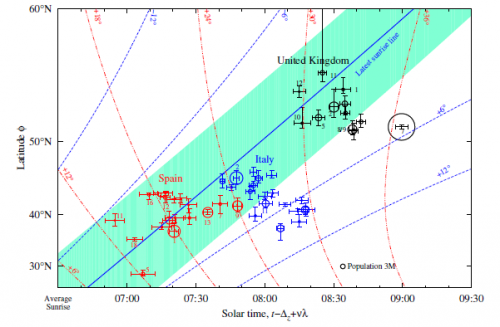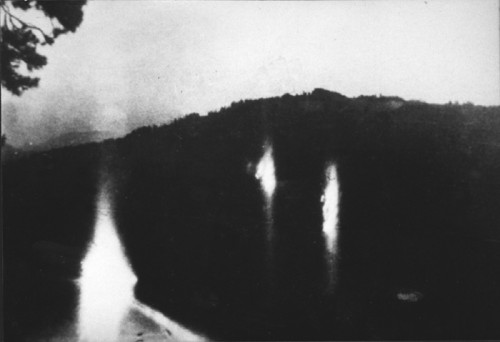Tag archives: geophysics
Physicist explains why Spaniards aren’t actually lazy

Graph of latitude versus solar time for when people in Spain (red), Italy (blue) and the UK (black) start working. The blue line is sunrise at winter solstice while the green band is 30 minutes either side of this.
By Matin Durrani
We’re not the kind of people here at Physics World who resort to national stereotypes – if anything, physicists are pretty much the same the world over no matter where they’re from.
But in the case of Spain, there is a widely held (and probably unfair) view that the Spanish are a bit on the lazy side, saddled with a reputation for long lunches, snoozy siestas and late nights out.
In fact, the Spanish are aware of the problem and there has been much debate in the Spanish media over what can be done to improve productivity and working lives. A Spanish parliamentary commission last year even proposed that the country should turn its clocks back by an hour from Central European Time (CET) to Greenwich Mean Time (GMT). Doing so, the commision said, would improve “productivity, absenteeism, stress, accidents and school drop-out rates”.
View all posts by this author | View this author's profile
Cracking the earthquake lights mystery and out-of-this-world technology

A photograph of streams of lights taken in 1977 near Brasov, Romania, about 100 km from the epicentre of a M 7.2 earthquake. (Courtesy: Seismological Society of America)
By Tushna Commissariat
In case you missed it, I was at the APS March meeting in Denver, Colorado last week and I was blogging about a whole host of interesting talks and sessions that I attended. Although I am back in Bristol now, there were one or two other talks that I thought covered some very interesting physics, so here’s a catch-up.
Slip slidin’ away
Seasoned physicsworld.com readers will remember that earlier this year, we featured a rather intriguing story on the phenomenon of earthquake lights – the mysterious and unpredictable glowing lights that seem to appear before some earthquakes. First documented in the 1600s and seen as recently as the Fukushima earthquake of 2011, the “unidentified glowing objects” add to the long list of possible earthquake precursors, and so are of interest. The study that we wrote about in January looked at 65 well-documented events of such lights and concluded that they may occur thanks to a particular type of geological fault – a subvertical fault – causing the earthquake.
Postcard from Rio – following in Einstein’s footsteps

Einstein visiting Brazil’s National Observatory in 1925. (Courtesy: Observatório Nacional)
By Matin Durrani in Rio de Janeiro
I don’t think I’ve ever talked to the head of a physics lab with a parrot screeching outside the window. But that was the case today when I visited the Brazil’s National Observatory – the country’s oldest scientific institution, founded in 1827 by Emperor Dom Pedro I just five years after the country won independence from Portugal.
The parrot was somewhere in the lush green trees directly outside the open windows of the director’s elegant first-floor office, which is currently occupied by the physicist Joao dos Anjos, who took over as head of the observatory earlier this year. (He also claimed his secretary had seen a ghost in the office recently, but that’s another story.)
After closing the windows’ shutters and switching on the air-conditioning, Dos Anjos explained how the observatory is now focused on three main activities – astronomy, geophysics and metrology. In fact, the observatory is still the official body in Brazil for setting time, which was one of its original missions, along with determining geographical locations and studying the country’s climate.
View all posts by this author | View this author's profile